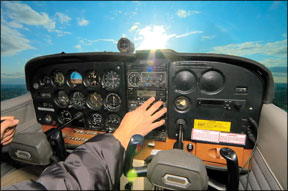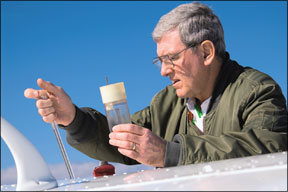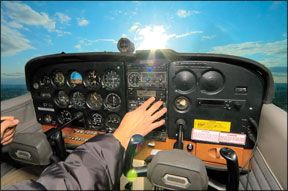Your hands freeze on the controls as your instructor barks out, “No! Dont do that! Why on Earth did you just do that? What is going on with you today? Whoever told you to do it that way?” Ever been there? Ever felt even uncomfortably close? Say, somewhere between righteous resentment and being humiliated into a near-comatose state? (Come on now; be honest.) 288 Well, its one thing to be debating some acknowledged subtlety of technique in a classroom, like leaning, or when to bring up the gear after takeoff in a retractable gear airplane (or when to lower them, for that matter). Its another thing entirely when personal preferences assume the elevated stature of right vs. wrong (and worse, a pilots self-esteem gets pummeled in the process). In the case of new pilots in particular, it can be the greatest disservice an instructor can offer. Perspectives To succeed in aviation, we develop the athletes ability to live in the present moment, at times exercising every last ounce of skill, discipline and judgment-wisdom, if you will. Well, were at least cognizant of whats around us, even while were reaching back in our minds for the knowledge we have acquired at an earlier time. Although there is very little athletics in the serenity of cruise flight, throw in one or more of any number of challenges and, sooner or later, we all meet The Wall. It might not be quite as exhausting as when your leg muscles go anaerobic during too long of a run, but its just as real a limitation. Between Good and Better The ingredients in the recipe for what makes a good pilot dont have quantities attached to them, and what makes for the Right Stuff is pretty fuzzy. Just as the definition of the term “airmanship” is indistinct in the minds of most, in our day to day flying we sometimes forget there is a distinct difference between procedure and technique. Heres the key take-home point: Just because someone does something a different way doesnt necessarily mean that theres a lack of proficiency involved. Yes, for many critical actions, there is only one right way-but for even more of the things we do in aviation, there isnt just one way to get from Point A to Point B. That may mean going around the airplane counterclockwise on a preflight, choosing the “wing-low” method versus crabbing into a crosswind on final or-within the more rigid procedural realm of instrument flight-the exact way one chooses to enter a holding pattern. A Little Story When I was a student pilot, I had a great instructor. He didnt belittle me and he didnt show off-well, not too-what a great pilot he truly was and as far as I know, still is. He didnt micromanage me and he let me make my own mistakes, some of which I kicked myself around the block for, later. Of course, he did this so I could learn from my mistakes. In fact, I think he knew Id be kicking myself around the block on my way home from the airport. But he had his own particular philosophy about certain aspects of flying. I flew with him during training for both my Private pilot license and my Instrument rating. (The residence time of the average flight instructor was much greater then, upwards of a year or more.) He always taught me to keep my hand on the throttle below 3000 feet agl. In case something happens, my hand is already there, ready to take action, he said. Importantly, he never said, “Any other way is just wrong.” Thats just what he taught me. And as we know, first impressions stick with you-a long time. Ten years go by. Im flying with another instructor (at 2500 feet), and he sees my hand on the throttle. Why am I doing that, he wants to know. The rpms might creep up, he says, if I unknowingly were to push it in as I was resting my hand there. Okay, I say, point taken-regardless of whether thats a good reason to remove my hand from a control-and I let it go. Insights 288 When someone makes a new pilot (or even an old one) think twice about something they were taught, yes, that can be a good thing-if its done right. One of the great benefits of flying with many different instructors is the tips and tricks you pick up. I used to agonize over not really being able to accurately tell what the fuel levels in the main and auxiliary tanks were during preflights of the Robinson helicopters I learned to fly. Then one day, my CFI, Nicklas Brandt, shows me how, by tapping up the outside of the tanks from the bottom up, you can easily tell when the pitch changes, and thus know where the fuel level really is. (A calibrated dipstick, as shown in the photograph below, would be better, but Im trying to make a point here.) It was one of those “came the dawn” realizations. Whap! How obvious! Why didnt I think of that? Preferences, PERFECTION… But when someone dispenses information as gospel which you even suspect might involve personal preferences rather than being inviolate and absolute (and unless they have a long white beard or perhaps an FRS after their name), I would say make a note of it, sure, but keep an open mind. Always be ready to soak up new knowledge-even if its just a good way to do the same thing you already know how to do. The emergency procedures in your POH, the FAA regulations we must obey: They dont have much latitude. But, how you preflight, or whether you think its best to make your radio calls in the pattern while youre turning because thats when other pilots are most likely to see you…thats the realm of technique, and of the thinking pilot. We can always stand to improve our skills through procedural drills, yes. But theres always more. …And More Even though we may fly with dispassionate surgical precision, flight also creates a place within us for enchantment and wonder; it broadens our perspective on the world, but it also broadens our soul. Such ostensible omniscience ought to breed a more philosophical tolerance for differences in how we do what we do, even though of course, we must respect the limits and laws of physics allowing us to fly through such an insubstantial medium as air. Dont ever let anyone bully you out of being able to think. Ive been there. It can be demeaning, and its not fun. Also, dont let anyone bully you into doing something that isnt safe. Bottom Line Many things are not inscribed in stone. Holding pattern entries, leaning oversquare, even such a sacrosanct procedure as how best to depart a short field has been taken to task by some of the older pelicans among us. Several years ago, 

Well, Im not going to try that with the next proverbial concrete wall, but it sure made me think. Its interesting stuff. And if anyone is in a thinking game, ladies and gentlemen, its us.
Just remember that even though one pilots “technique” might be another pilots pet peeve, most of us are doing the best we know how. Remember to keep your mind open to new experiences.




